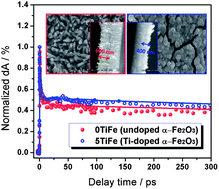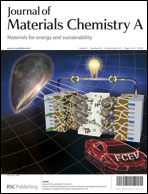Physical and photoelectrochemical characterization of Ti-doped hematite photoanodes prepared by solution growth†
Abstract
We present the fabrication and characterization of Ti-doped hematite (α-Fe2O3) films for application as photoanodes in photoelectrochemical (PEC) cells for water splitting. It is demonstrated that Ti doping significantly improves the PEC activity as the photocurrent at 1.0 V vs. Ag/AgCl electrode for a 400 nm thick Ti-doped film (0.66 mA cm−2) was found to be ∼14 times higher than that of an undoped film (0.045 mA cm−2). The films were characterized by X-ray diffraction (XRD), Raman spectroscopy, X-ray photoelectron spectroscopy (XPS), and ultrafast transient absorption spectroscopy to obtain information about their structural, electronic, and charge carrier dynamic properties. Based on characterization of the chemical states of the involved elements as well as the charge carrier dynamics of the films with Ti doping, it appears that the photocurrent enhancement is related to an increase in charge carrier density or reduced electron–hole recombination. The highest incident photon conversion efficiency (IPCE) measured for this system was 27.0% at 360 nm at a potential of 1.23 V vs. reversible hydrogen electrode (RHE), which was obtained on a 400 nm thick Ti-doped α-Fe2O3 film.


 Please wait while we load your content...
Please wait while we load your content...